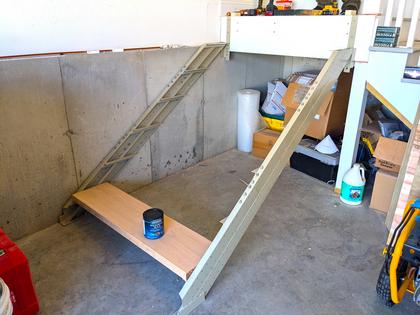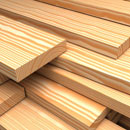Ask the Builder: Erector set stairs in an hour
You probably give little thought to the stairs you go up or down to reach different levels of your home, deck or patio. I’ll wager that if I handed you a measuring tape, a framing square, a pencil and a level, you’d scratch your head and not know where to start the layout required to build a safe set of code-compliant stairs.
The good news is you can eliminate all that hassle by purchasing a product I just installed recently in my son’s garage. I was astonished at how easy it was to create a safe set of steps leading from the first floor of his home down to his concrete garage floor. The best part is that it brought back fond memories of the erector set toy I had as a child.
To understand stairs, let's talk about floors. Like many Americans, you might live in a home with a wood-floor system. The flooring in your home is supported by wood joists. These joists need to be strong because they often span distances of 12 feet or more.
Stairs are similar to wood floors in this way: On a set of stairs, there is flooring that your feet walk on, called treads. Many stairs also have risers, which are the vertical surfaces rising from the treads. The stair treads and risers are fastened to and held firm by stringers, which are analogous to the joists under a floor.
The stringers are the bones of the stairs. They’re what support you and your friend when you’re carrying up or down the 300-pound refrigerator.
It’s essential to understand that many sets of stairs that you regularly traverse may be borderline unsafe. All too many carpenters take a shortcut when building stairs. They start with strong dimensional 2x12s (superior for floor joists and stringers), and cut out triangular notches to create surfaces to attach the risers and the treads. This surgery transforms the strong 2x12s into sub-standard 2x6s. You’d never want floor joists in your home to be bouncy 2x6s, so why would you ever accept them in a set of stairs?
I never cut notches in my wood stair stringers. I created 1/2-inch-deep mortises in my 2x12s to preserve the strength of the stringers. These mortises take much more time to create, which is why most carpenters don’t do it.
The prefabricated stringers I worked with recently at my son’s house are made from steel. They are not notched. The manufacturer, Fast-Stairs, welds steel angle irons onto the stringers that support the treads. The critical angled cuts required that allow the stringers to rest against the wall, landing and floor have been made at the factory.
Fast-Stairs stringer kits are available in four different models. It just so happened that the distance from the landing in my son’s garage to his concrete floor allowed us to use the model A. This one is closest to the safest and most comfortable combination of riser height to tread depth.
I always built my own stairs, when I could control the distance between floor levels, with a 7 1/2-inch riser and a 10-inch tread. The model A stringers come with a 7 7/16-inch riser and a 10 1/4-inch tread. This creates a 36.5-degree angle.
Once you’ve selected the stringer model, you need to match up with the height difference between the levels your stairs will serve. You get all the parts you need to create the stairs, except for the treads and the railing, which you need to provide.
All of the heavy-duty bolts and washers are included to assemble the steel parts. All of the components have been pre-drilled and the required holes threaded. You even get a large hex wrench to tighten the bolts.
My son decided to use solid oak treads. A local lumber mill had affordable pieces of sanded oak that were 1 3/4 inches thick. The oak was select grade with no knots. He also wanted an open-stairs look, so there are no risers. The finished look is amazing.
I decided to create a series of very short videos about the stairs. I show the initial problem we faced and why we had to install new stairs. I then decided to focus on the components and the things you need to know as you proceed with the assembly.
You can view all of these videos at AsktheBuilder.com. Once there, use my search engine and type: “Fast Stairs.” You should see a page that has links to each and every video.
I rarely mention companies by name in my columns for a host of reasons. However, stair safety is one of my great concerns, and I feel it’s appropriate to let you know where you can get one of these great stringer kits. Go to https://fast-stairs.com and view photographs of amazing stairs built using the exact same kit I used.
Subscribe to Tim’s FREE newsletter at AsktheBuilder.com. Tim offers phone coaching calls if you get stuck during a DIY job. Go here: go.askthebuilder.com/coaching
©2025 Tim Carter. Distributed by Tribune Content Agency, LLC.






























Comments